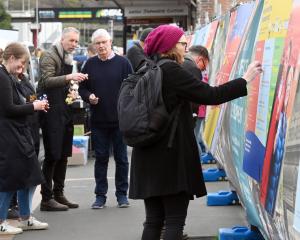This birthday called for a picnic lunch of bacon and egg tart, stuffed eggs, sandwiches and a chocolate cake, all from a newly acquired book of recipes from the 1930s and 1940s, collected by Alexa Johnston in her Ladies, a Plate.
Those recipes are reminiscent of my mother's afternoon tea parties where the cinnamon oysters were always top of the cake stand. Childhood and old age merge gracefully and seamlessly when birthdays are celebrated with Ladies, a Plate fare.
The picnic was a prelude to a visit to Maple Glen, an expansive garden set in the heart of Southland where daffodils, heaths, violas and fritillaries, trilliums, rhododendrons and camellias all blend with wild fowl and exotic birds to create great natural beauty. Well, 77 deserves such a birthday in such a setting.
Time concertinas. It is never a reliable measure. It works in harness with memory and at 77 there is a plethora of memory, some sharp and others dim. What Time will do is to bring things into focus for memory to have a play with.
But it had ideas, and those called for innovation and inspired leadership at an individual school level.
Up till then there had never been any attempt to couple with industry to provide experiences in the workplace, nor had basic core learning ever been addressed through individual education plans. This was a time of full employment when a great many kids left school at 15, confident of a job, but there were those whose capabilities were limited or damaged by their upbringing.
There had to be new methods explored to lift them out of poverty, and a safety net secure enough to withstand their abuse, neglect and deprivation. Home visiting and parental education were part of this mix.
Time does not let you forget those mean little houses crammed beside the gasworks in South Dunedin, dark varnished dados down the hall, ceilings blackened with smoke, a lifeless coal range and cracked Congoleum on the kitchen table.
On reflection, I now realise that these experiences formed an educational philosophy, which can be tracked from then till now, down one continuous road. Schools are living organisms, each with its own DNA. And where poverty is endemic, education has to become a liberating force.
A kaleidoscope of teaching in the 1960s outside the classroom - with a Sunday School of play-making, story-telling and dramatic presentations; WEA classes in rural and urban areas; Plunket groups; YWCA activities for kids; speech and drama courses; addressing the needs of bikie gangs who told their own stories - all pointed in the same direction: life was an extraordinary carnival into which each individual must gain an entry ticket.
There was ferment in the arts, in theatre and in politics; and in this ferment, Keith and I brought up our three children.
They had ample room in a substantial old villa and grounds to build tree houses, dig imaginary roadworks, run model trains, enact childhood fantasies, enjoy friendships and coexist amicably with adults.
And there was that 100-year-old, packed-mud cottage in Naseby we bought for a song. We didn't intrude much there, giving them full rein to develop their independence and self-reliance. We worked mainly by instinct and a deep affection.
They have now graduated far into adulthood. We do not count success for them in terms of how much they earn or their professional status, but what resonates for us is that they still enjoy each other's company and take an occasional nod in our direction, and that their partners nod too in unison.
And as night follows day, they come together in the expectation of high-standard Christmas fare. And they get it too! Because I plan it: cold pork and decorated ham, salads in aspic, Jersey Bennes, jellies of champagne and raspberries (always Outram for the potatoes and the raspberries).
It is a symptom of my ageing, I suppose, that I plan a family Christmas months in advance, since it forces my mind to a rich sequence of family images. It is indeed the best of good fortunes when you can nestle into old age cosseting a multitude of family scenes, future and past.
Generations merge in curious ways. My granddaughter has recently gained an awareness of my father's personality.
He was a great-grandfather she never knew, but she responded to him, and he has become real through her reading of his letters to my mother from Gallipoli: "Just a hurried scribble, we are off at last. It will be a decent slather-up this time. If anything happens to a fellow, you will be sent the ring, value it as I have valued it, Tib. I often sat and looked at it and thought of the old times".
The letters have yellowed pages now, with browned edges in places, and my granddaughter says they must be preserved.
The preservation should not be because they are relics of World War 1, but because they are the feelings of a very fine man, deeply in love. Ngahuia understands this, knowing that preservation is for many and varied reasons, some personal and very private, and others to enrich posterity. Her youth displays a wisdom drawn from traditions of the Scottish Highlands and from the Northland Ngapuhi.
I'm reminded that it is into the hands of the young we place responsibility for future decision-making, at a time when abuse of the Earth and its resources causes concern for the planet's sustainability. Yet we often show little respect and compassion for our youth. A most curious twist of logic.
When I got to lead a school of hundreds of young women from differing ethnic groups, different social backgrounds, with various dreams and aspirations and levels of ability, I learned the young have an intuitive kind of wisdom.
To lead a school is a remarkable, albeit challenging, vocation. It is remarkable because of its constant exposure to the human condition and challenging because of the responsibility of ensuring that every one of those hundreds of young women must get a decent chance to better herself, and that as few human talents as possible should go to waste.
A school is a very special community affected by the social and economic issues of the time in the same way as all communities, but with the capability to act within its own integrity. That is what sets it apart.
This was evident from my primary school education, which took place during the whole of World War 2. The school stood on the brow of a hill overlooking a valley. It was a bluestone school, solid and square.
Within, there was a sense of order, and it offered security against a chaotic social background, where fathers and brothers enlisted for armed service and were drafted to battlefields in Crete, Egypt, Greece, the Pacific: some killed or wounded, others missing, some prisoners of war.
Community bonding was all-important then, and the school became the refuge. We drank our milk in bottles from crates before playtime and - after the chanting of "Thank you for the world so sweet, thank you for the food we eat" - we took red apples wrapped in tissue paper from wooden boxes to be eaten on the way home.
So, we got the feeling that there was someone out there who had an interest in looking after us as well as the teachers who made sure on wet days we changed from gumboots to slippers, and left the wet raincoats on a coat peg with our own name and a special picture. We felt very secure, secure enough to learn a lot, with all learning an adventure.
Those signs of care, symbols of safety and security, together with learning adventures, are basic elements of a sound education. It was these elements I wanted to make sure were embedded in the educational experiences of those hundreds of young women.
In the '50s, the leadership and influence of Dr Beeby, director of education, created a climate for educational thinking that was totally child-centred and founded on egalitarian principles. You couldn't escape capturing those ideals and they remained as part and parcel of your practice.
It was a catch-cry that New Zealand was the best place to bring up a family. Our enlightened policies were internationally recognised. It was the best of times to take into the school community those ideals, optimism and freedom to innovate. And even into the 1970s this freedom continued.
Where we saw a need to provide ongoing care for the babies of staff, for the babies of solo mothers to allow continuity of their education, and for practical sessions in mothercraft for junior students, we had a freedom to establish a pre-school on campus.
That pre-school still stands and is testimony to the fact that education is both continuous and lifelong.
There was a freedom to establish a school-based curriculum in areas where community and school saw a need, and in the recession of the 1980s we were free to develop self-sufficiency programmes where students stocked and ran their own handcraft shop in South Dunedin; worked land and sold parsley to shops; and dried flowers and planted bulbs.
They gardened in teams, and the money they earned was theirs. What we did was unconsciously return to the experiment of the 1960s and we developed skill-based courses with employers in which progress was assessed in the workplace as well as the classroom.
All we wanted to do was to avoid a second generation of dole dependency. And we felt at liberty to identify the outcomes we wanted: that every girl should leave school confident of a place to go, some spared of the corrosive effect of poverty.
I've got to wondering if we have ideals now. If we do, they have to be polished up into cost-effectiveness and measured if they are to have any value. I think that something called outputs determines the worth of an ideal now, and because you can count outputs, ideals get in the way.
Anyhow, how can we measure improving a human condition? Or making a kid feel good about achieving, when for some a big achievement looks positively minute in the scheme of things? With this fetish for measurement, a new language is abroad now.
I have not mastered it; nor will I. That language is raw and passionless and without humanity. It seems to be bred from imposition, control and restriction, three pretty damning elements.
But things that have been irritants and those that have required a substantial commitment can take on a different perspective in the face of one traumatic episode.
It jolts you into an understanding of the meaning and purpose of life. This happened when Keith and I set out to Central Otago to greet the family for Christmas. We ended up in hospital, cut out of the car, flown in by helicopter, Keith's life saved only by the skill and teamwork of hospital staff.
His struggle, over months, to learn to talk, to master everyday tasks like crossing a road, supermarket shopping, making a cup of tea, remembering days and dates, the drift of conversation, a person's name, and always the presence of debilitating pain.
Time stopped for him in a dark hole of 48 days of unrecovered memory. For me, Time measured the little bits of his recovery and imperceptibly strengthened the respect and faith I had in him.
Now, celebrations take on greater importance; the garden, dog walks with Millie and Harry, conversations with friends, family contacts, his writing and reading.
And a bridge four, with two in their 90s, one in her 80s, and sharp at 3.30pm, on an embroidered tablecloth, with sandwiches and a cream sponge or pavlova.
This supplied me with enough of the niceties of past living to realise we are a slovenly lot with our chocolate biscuits and cuppas, and our bridge may not be up to scratch either.
Their purpose in what was left of life was to use present Time wisely. They never referred to their own age as "old". Three have died recently, within a short space of time. The experience was illustrated completely for me in these lines: "life and death upon one tether/And running beautiful together".
So now it is time to conserve breath and allow observation to become keener. You discover that what you suspected to be true is true: that the good lies in community. It is there where a committed, responsive, younger generation wrap around our most vulnerable youth the services they need.
It is there where they support the victim, shelter the abused and heal the raped. It is in the community that the poor are fed, and efforts made to prevent the saying "the poor will always be with you" from becoming a truism.
I find age has definitely sharpened my powers of observation to recognise the infinite variety of inner resources that the younger generation possess, and to admire their quick intelligence and ability.
I have been with them as they challenge in a sharp and penetrating way the fallacy that it is impossible to turn around a fourth generation of deprivation.
I watch as they tick the boxes for funding and note they reject the new language. It is interesting to be with them as they play host to politicians and researchers, government officials and agencies, who fumble around like a kind of Peeping Tom to find a cost-effective way to address the problem of a crippling wasteland of human resources and increase in crime. I note that the one thing that has eluded measurement is the cost of doing nothing.
So, I can predict with some surety and take comfort from the fact that working from a community base the younger generation will find a way to revitalise the consciences of those who in their search for efficiency and accountability have turned away from listening and seeing what really is.
After two weeks of on and off writing and thinking, I put down my pen. Katie and her partner Laura will come for tea tonight with Hannah, a large, tiger-coloured SPCA-rescued dog. She will be 102 in human years.
The oldest living being I have ever known! They will protest at the amount of cream over the apple pie, but she will look around for a titbit.
Hannah can teach us all a thing or two about old age since she is many, many fathoms deep into it. Slow-moving now and very, very patient, she appreciates simple comforts. Warmth to her is paramount as she follows the sun, or stretches out in front of the fire.
She is no longer interested in how the wider world works, but focuses on making her little space an Everywhere.
• THE BOOK
This is an extract from:-
Loving All of It:
Eminent New Zealanders Write About Growing Old,
which is out now, edited by Gordon McLauchlan.
$45.
All royalties go to the Starship Foundation.












